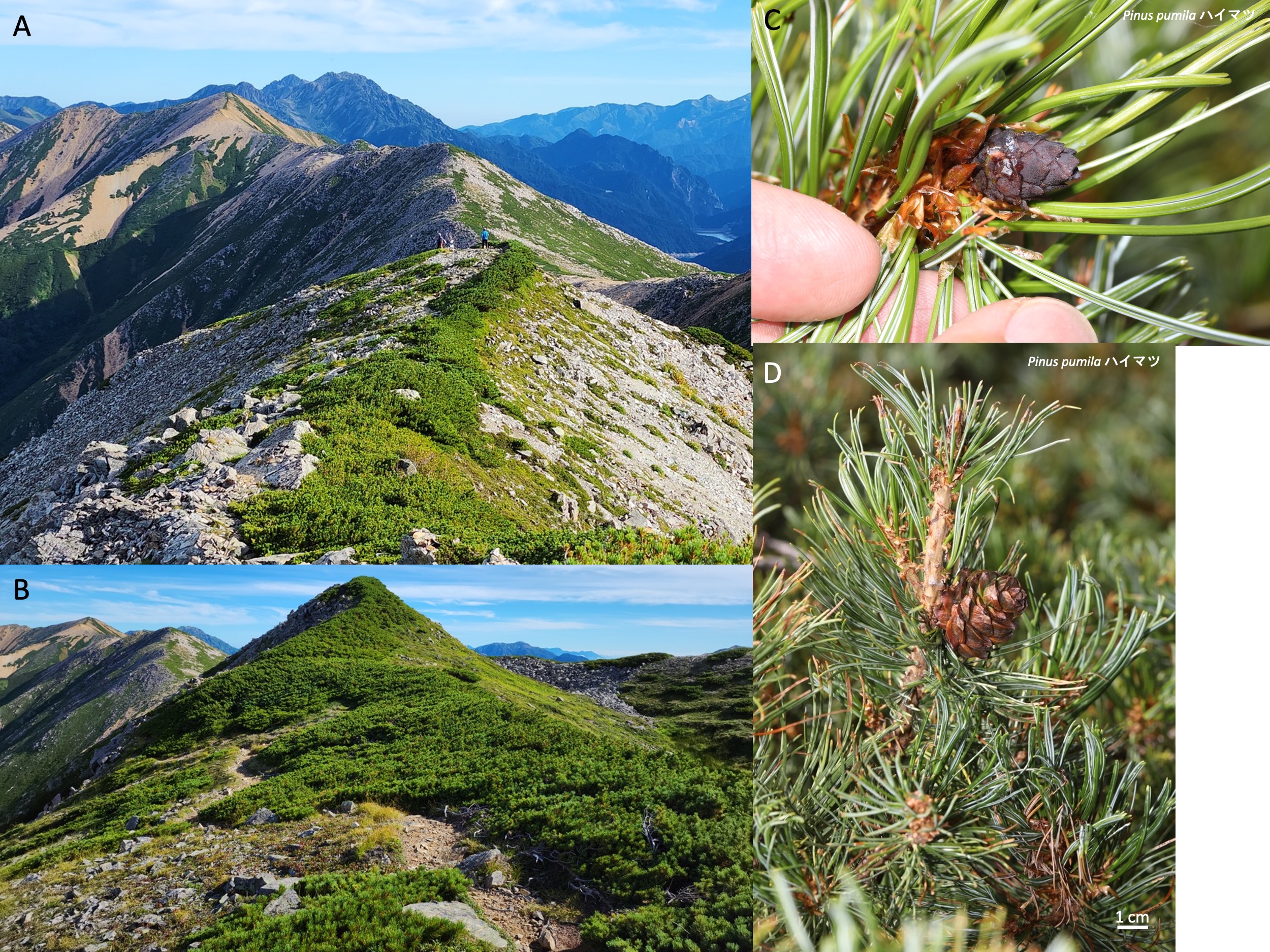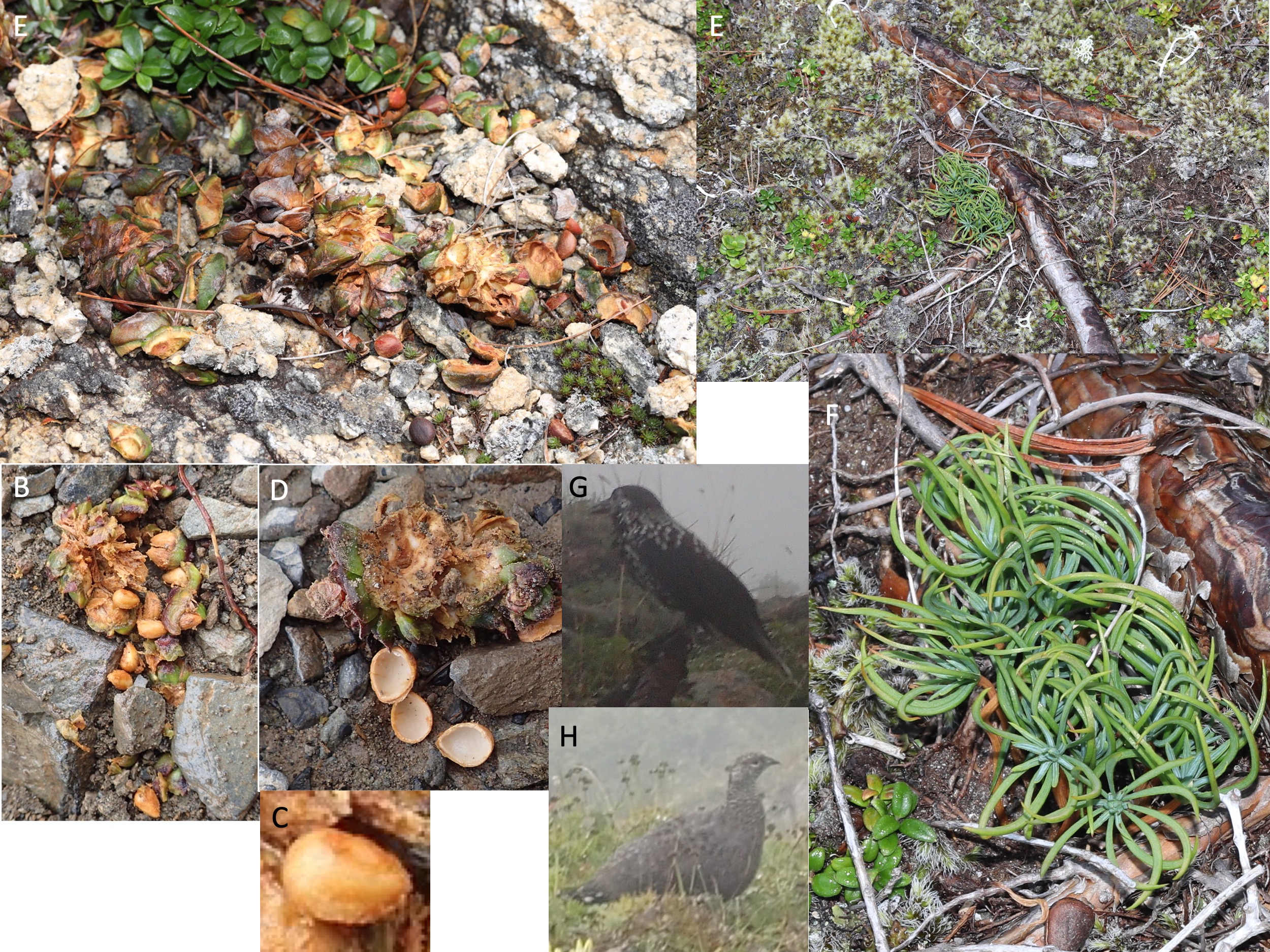
ハイマツは森林限界を超えた尾根筋(A)や山頂(B)に生育する(A、B:ともに北アルプス水晶岳から赤牛岳への尾根筋)。受精した松ぼっくり(C)は、翌年に成熟する(D)。
The Japanese stone pine Pinus pumila, known as “Haimatsu“ as a Japanese name grows on ridgelines (A) and mountain peaks (B) beyond the forest limit (A, B: both refer to the ridgeline from Mount Suisho-dake to Mount Akaushi-dake in the Northern Alps, Japan). The fertilized pine cones (C) mature in the following year (D).

ハイマツの松ぼっくりの軸は細く、容易に枝から取れるが、林床には見つからない。一方、ハイマツ帯の岩の上や登山道には、ばらばらになった松ぼっくりが3〜5個くらい落ちているのをよく見かける(E)。ハイマツの種子は多くのマツ属の種子と異なり翼が無い(C)。また、いくつかの種子は種皮が割れて中身がなくなっているが、落ちている種子の数は松ぼっくりに入っている種子数よりもずっと少ない。さらに、ハイマツの芽生えは、たいがい、いくつか固まって生えている(E、F:FはEの中央部分の拡大)。この理由について、Hayashida (2003)は北海道のアポイ岳で研究を行った。ホシガラス(G:長野県仙丈ヶ岳で撮影)は、松ぼっくりがまだ未熟な7月半ばから松ぼっくりを壊して、未熟な種を食べる。8月になり茶色く柄がしおれて取りやすくなった成熟した松ぼっくりができるようになると、茶色いものを選んでもぎ取る。くちばしで種皮を割り、いくつかの種子の中身を食べる。一方、残りの種子のうち、内乳の発達した種子を選んで、舌下嚢(sublingual pouch)に貯める。1回に2〜10個の松ぼっくりから15〜78個の種子を採取する。8月の繁殖期、種子は繁殖場所である亜高山帯の樹林下に運ばれ、数か所に分けて数センチの深さに貯蔵される。貯蔵された一部の種子は、忘れられて発芽する。しかし、亜高山帯はハイマツの自生域より低く、かつ、林床であるため、芽生えは枯れてしまう。一方、繁殖期を終えた9月になると、ホシガラスは、採取した種子をハイマツの自生地近くに埋めるようになる。ここで、忘れられて発芽した種子は成長し、ハイマツの種子繁殖は成功する。ホシガラスは、1 kmくらいまで種子を運ぶと考えられており、効率の良い種子散布である。ライチョウ(H)やクマなどもハイマツの種子を食べるが、96%の種子はホシガラスによって運ばれる。ハイマツ以外にも、北米のP. albicaulis、P. flexilis、P. edulis、ヨーロッパのP. cembra、シベリアのP. sibirica、東アジアのP. koraiensisでも知られている(各文献はHayashida [2003] 参照)。
The cones of the Japanese stone pine, Pinus pumila, referred to as “Haimatsu” as a Japanese name have slender stalks that can be easily detached from the branches but are not typically found on the forest floor. On the other hand, when in the rocky areas and hiking trails within the P. pumila zone, it is common to come across scattered three to five fallen cones (E). Unlike many other pine species, P. pumila seeds lack wings (C). You may find some ruptured seed coats with empty interiors. The number of seeds on the ground is often much lower than the total number of seeds inside the cones. Furthermore, P. pumila seedlings tend to grow in clusters (E, F: F is an enlargement of the central part of E). To explain this phenomenon, Hayashida (2003) conducted research on Mount Apoi in Hokkaido. The Eurasian nutcracker, Nucifraga caryocatactes (G: photographed at Mount Senjo in Nagano Prefecture) starts damaging the cones and consuming immature seeds from mid-July when the cones are still immature. As August approaches, mature cones turn brown, and their stalks wither, making them easier to pick. Nutcrackers select the brown ones, crack them open with their beaks, and eat the contents of some seeds. Meanwhile, they pick out the well-developed seeds from the remaining ones and store them in a sublingual pouch. They collect 15 to 78 seeds from 2 to 10 cones in one feeding session. During the breeding season in August, the crows transport the seeds to the subalpine forest floor, their breeding site, and store them in several locations at a depth of a few centimeters. Some of these stored seeds are forgotten and end up germinating. However, since the subalpine zone is lower than the natural habitat of P. pumila and covered with forest litter, most of the seedlings perish. On the other hand, by September, after the breeding season, the large-billed crows start burying the seeds they collected near the P. pumila‘s natural habitat. Here, the forgotten seeds can grow, and P. pumila seed reproduction is successful. It is believed that nutcrackers can transport seeds up to approximately 1 km, making their seed dispersal highly efficient. Although other animals such as rock ptarmigans Lagopus muta (H) and bears also eat P. pumila seeds, 96% of the seeds are transported by nutcrackers. This unique seed dispersal strategy is observed not only in P. pumila but also in other species such as Pinus albicaulis, Pinus flexilis, Pinus edulis in North America, Pinus cembra in Europe, Pinus sibirica in Siberia, and Pinus koraiensis in East Asia (references are available in Hayashida [2003]).
Hayashida, M. 2003. Seed dispersal of Japanese stone pine by the Eurasian Nutcracker. Ornithol. Sci. 2: 33-40.
